Disobeying order: Ranjani Shettar in
the Barbican Conservatory
Arriving at the Barbican Centre’s
Conservatory space to experience the sculptural work of Indian sculptor Ranjani
Shettar, Cindy Huang gets lost within an ever-overgrowing jungle, leading to
thoughts on post-colonial reimaginings of the botanical space.
The day before I see Ranjani Shettar’s Cloud songs on the horizon, I had a chat with a friend in Melbourne
about my monstera unfurling a new leaf. She sent me a photo of a wild monstera
tree near her flat, two fruits like green maize ears pointing to the sky,
the plant had the most enormous leaves of its kind I have ever seen. Its fenestrated
leaves with numerous side slits and holes along the midribs made it look like a
skeleton of a giant ancient creature. I had never seen any monstera thriving
like that in London.
Perhaps this is partly why I keep getting distracted by happy-looking plants in the Barbican Conservatory while visiting Shettar’s exhibition. But the suspended sculptures, twirling silently and almost imperceptibly in the air, also encourage my attention to drift into the lush foliage around me. Made of handwoven and naturally dyed muslin, the sculptures conjure organic forms – blooming flowers, young buds, soft tendrils, and far-reaching vines – directing visitors’ eyes to their immediate surroundings through creating unexpected visual dialogues with different plants in the space.
![]()
![]()
As I move through the dense jungle, some parts of the work which gives the exhibition it’s title, Cloud songs on the horizon (2023), are at first reminiscent of fish skeletons, but then transform into an abstract parallel of the thick, oval leaves on a rubber plant nearby. Tentacles of In the thick of the twilight (2023) carefully extend towards the long, slightly curved petioles of a philodendron tree. The earthy palette and wrinkled surface of the sculptures find echoes in the papaya-coloured petals of pendant angel's trumpets.
As my eyes bounce between the sculptures and plants crowded around them, I gradually let go of the insistence on keeping the artworks in the centre of my attention. The sculptures condone my misdemeanour. They step back and blend into what would normally be background. The boundary between art and surroundings quickly dissolves in a tangled mass of vegetation. Spread across the irregularly shaped space of Barbican Conservatory, the exhibition declines visitors’ request for a single anchor for their wandering eyes – there is no centrepiece, no priority. Walking down the stairs after entering the conservatory, visitors are engulfed by a decentred viewing experience.
Or, this is actually not a viewing experience at all. On the contrary, by drawing my attention to the space and its plant inhabitants, the sculptures make room for other sensorial understanding of the space. I feel as if my senses are sprouting, growing and reaching deep into the green maze through the foliage. Tree branches and huge taro leaves brush across my arms from time to time. Their touch reminds me of my body’s physical embeddedness within the greenery. I hear distant sounds of water splashing and dripping. And I start noticing the smell of damp grass which permeate the conservatory. The air is warm and sticky.
![]()
![]()
Figs.iii,iv
The exhibition guides visitors away from the often-dominant visual perception. While non-visual sensorial experiences are amplified, the installation of the sculptures further resists visitors’ attempt to perceive them with just eyes. Overgrown branches and thick curtains of trailing leaves often partly conceal the sculptures nestled among them. I have to constantly walk around and shift from one tiptoeing foot to the other, looking for different angles to view the floating sculptures’ hidden parts.
As the sculptures slowly sway and turn in mid-air, their shapes and compositions change, and there are always some elements that remain invisible. In collaboration with the almost impenetrable planting, the sculptures create a constantly evolving landscape that refuses to be seized visually. Again and again, I try to find the best angle of looking, a vantage point that would let me get the whole picture. But the sculptures gently push me away.
The disorienting and fragmented experience fostered by the exhibition goes against the pursuit of order and control that underlies spaces such as botanic conservatories. In the Barbican Conservatory, as in any Western botanic gardens and greenhouses, tags with long Latin names indicate the foreign origins of the tropical plants and make clear their positions in an established taxonomy.
The Barbican Conservatory, opened in 1984, seems to belong to a different temporality in comparison to its cousins like Kew Gardens, which were built precisely when imperialist expansion was under way. However, this relatively young conservatory shares with its colonialism-driven predecessors the desire to collect and organise uprooted foreign plants. The desire to categorise specimens is intertwined with European colonising powers’ long-time desire to know and control. With the labelled and classified exotic specimens in botanic gardens, European colonisers establish themselves as a third-person inspector who has a clear overview of the world and understands its structure.
![]()
![]()
Figs.v,vi
Science is wielded as a sword that penetrates the dark, mysterious haze of nature. A neatly organised greenhouse, with plants from all the places reached by this sword, is a miniature version of the world tamed by the orderly overview. Confined under a glass canopy, the displaced plants become part of a beautiful, harmless snow globe.
The exhibition, however, quietly disobeys the desire for control and order that gave birth to Barbican Conservatory’s colonial predecessors. It submerges visitors in a sea of vegetation and denies their access to an all-powerful vantage point. My view is constantly blocked. I get lost. I look for the sculptures. I can’t find my way out. I touch and smell and hear the space. Without any explicit statement, the sculptures give me a tap on the shoulder, reminding me what an experience like this in a conservatory might imply.
The plants in Barbican Conservatory seem to know all this. Since they first met Shettar in December 2022, when she visited the exhibition site, the plants have grown like mad. Now, their scarred vines spread across the space like twisting pythons, and their massive leaves throw layered shadows into the space. They have trespassed the boundaries of their designated areas, blocked the walkways, hidden the name plaques and, slowly but insistently, grown into one with Shettar’s sculptures. They cover the concrete walls of the conservatory and reach for its glass roof. A dense, unruly, and impenetrable jungle has taken over the place.
Perhaps this is partly why I keep getting distracted by happy-looking plants in the Barbican Conservatory while visiting Shettar’s exhibition. But the suspended sculptures, twirling silently and almost imperceptibly in the air, also encourage my attention to drift into the lush foliage around me. Made of handwoven and naturally dyed muslin, the sculptures conjure organic forms – blooming flowers, young buds, soft tendrils, and far-reaching vines – directing visitors’ eyes to their immediate surroundings through creating unexpected visual dialogues with different plants in the space.
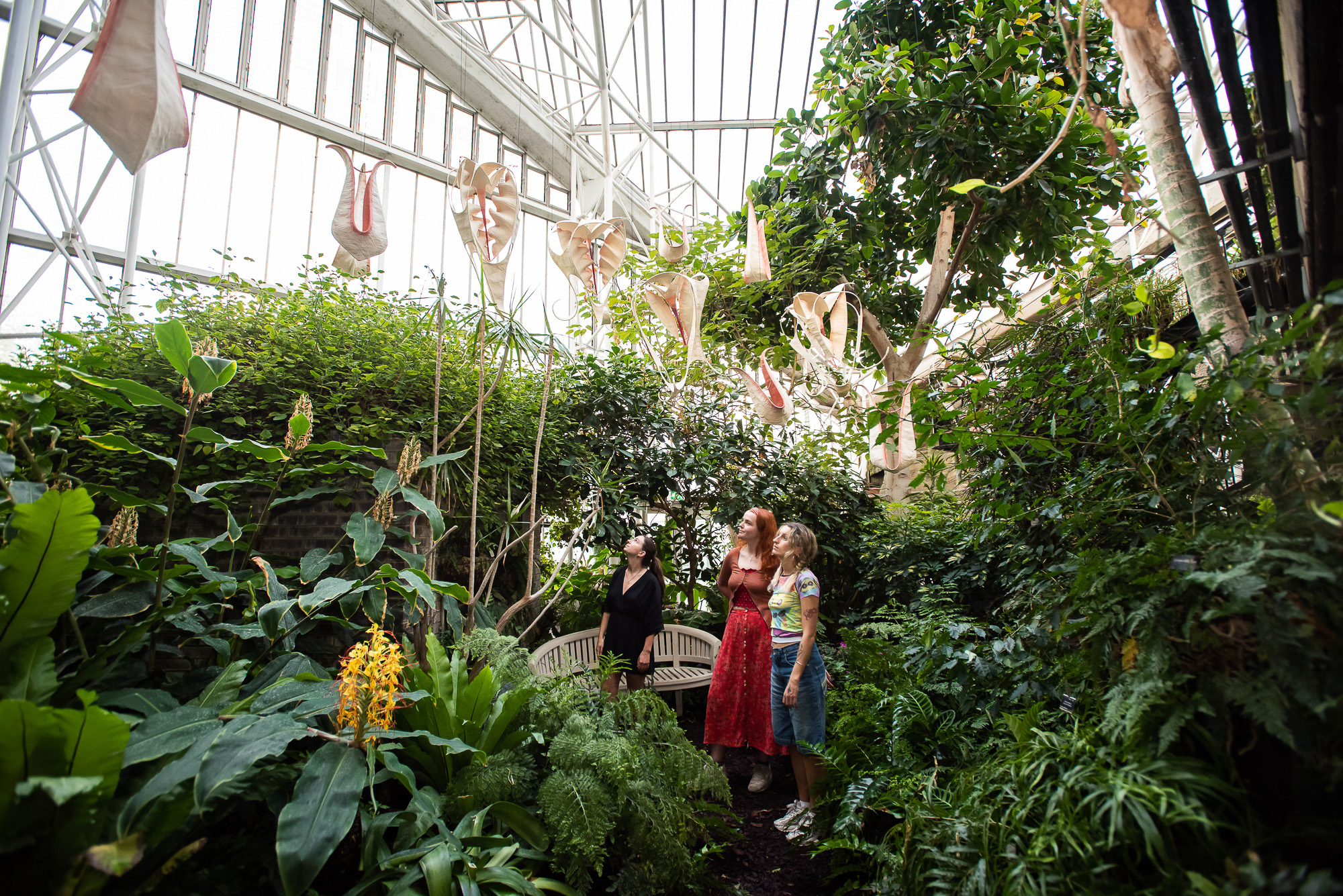
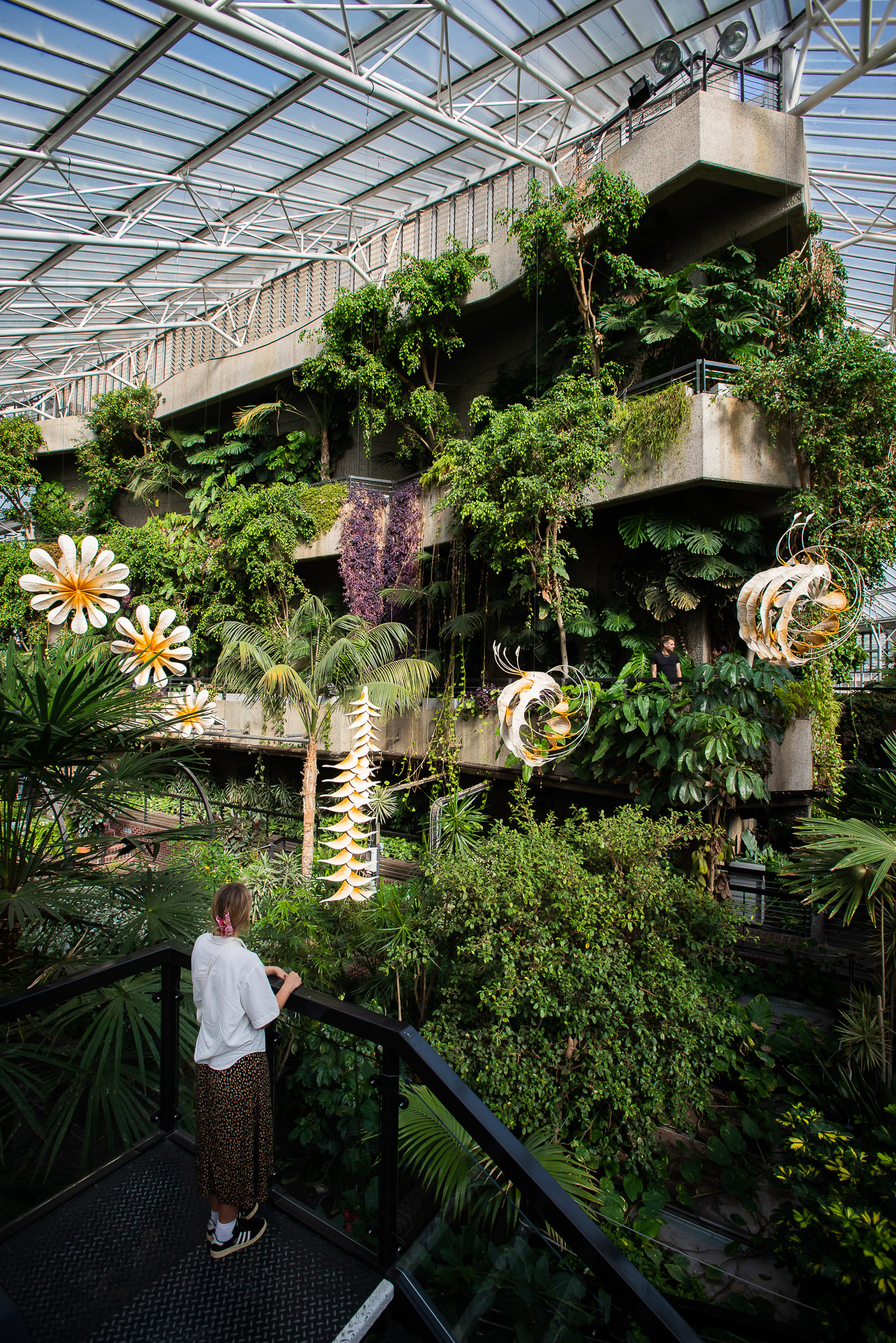
Figs.i,ii
As I move through the dense jungle, some parts of the work which gives the exhibition it’s title, Cloud songs on the horizon (2023), are at first reminiscent of fish skeletons, but then transform into an abstract parallel of the thick, oval leaves on a rubber plant nearby. Tentacles of In the thick of the twilight (2023) carefully extend towards the long, slightly curved petioles of a philodendron tree. The earthy palette and wrinkled surface of the sculptures find echoes in the papaya-coloured petals of pendant angel's trumpets.
As my eyes bounce between the sculptures and plants crowded around them, I gradually let go of the insistence on keeping the artworks in the centre of my attention. The sculptures condone my misdemeanour. They step back and blend into what would normally be background. The boundary between art and surroundings quickly dissolves in a tangled mass of vegetation. Spread across the irregularly shaped space of Barbican Conservatory, the exhibition declines visitors’ request for a single anchor for their wandering eyes – there is no centrepiece, no priority. Walking down the stairs after entering the conservatory, visitors are engulfed by a decentred viewing experience.
Or, this is actually not a viewing experience at all. On the contrary, by drawing my attention to the space and its plant inhabitants, the sculptures make room for other sensorial understanding of the space. I feel as if my senses are sprouting, growing and reaching deep into the green maze through the foliage. Tree branches and huge taro leaves brush across my arms from time to time. Their touch reminds me of my body’s physical embeddedness within the greenery. I hear distant sounds of water splashing and dripping. And I start noticing the smell of damp grass which permeate the conservatory. The air is warm and sticky.
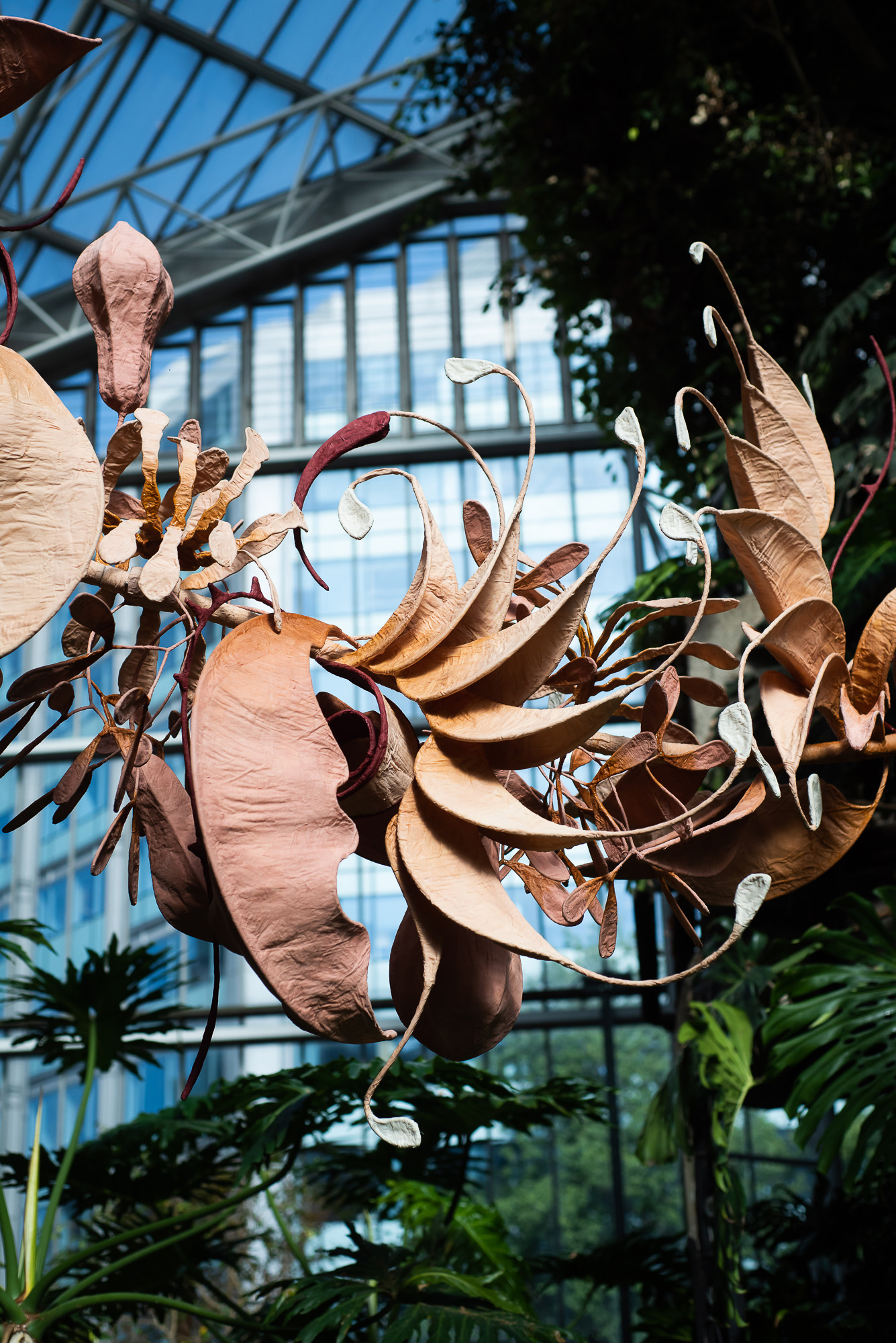
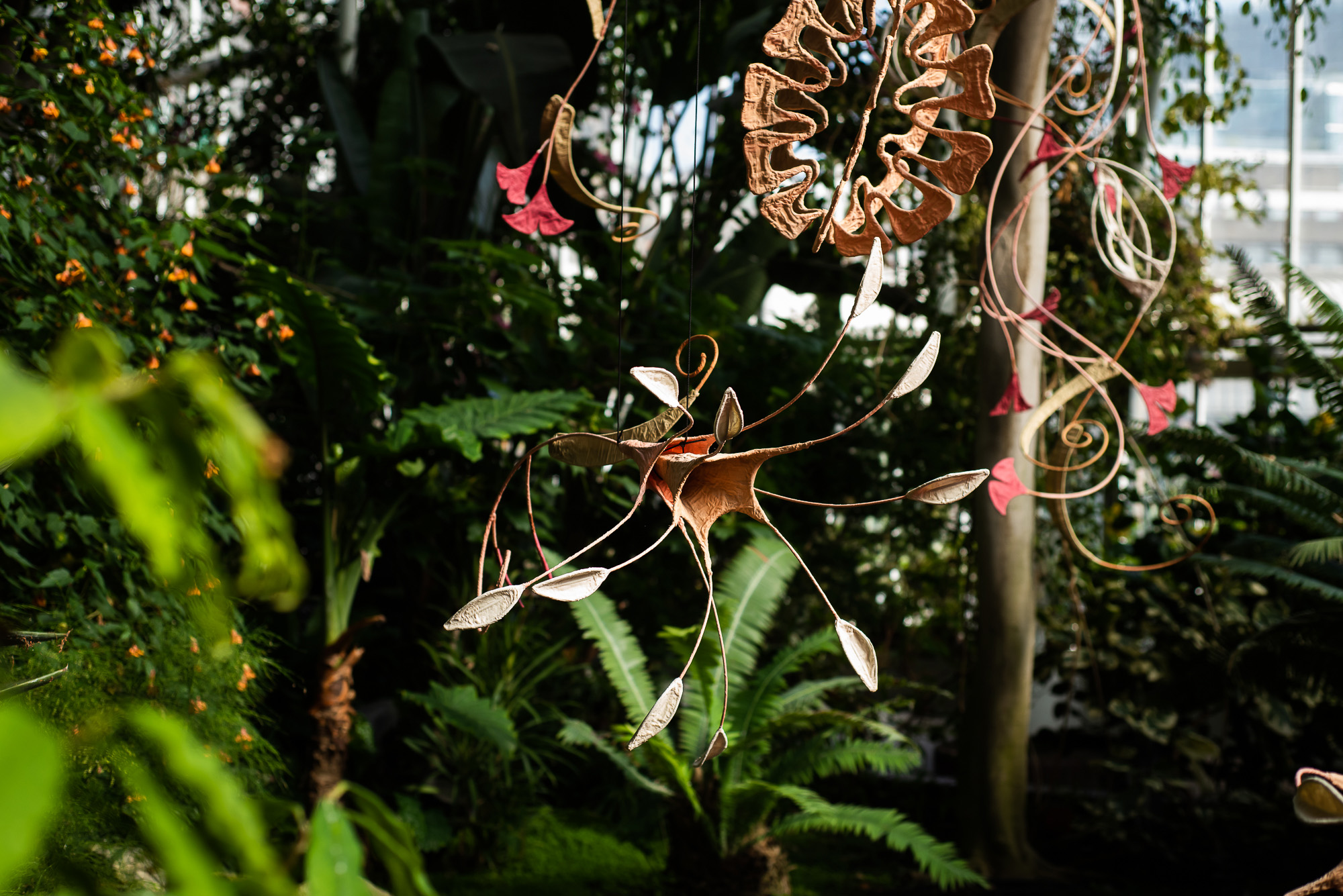
Figs.iii,iv
The exhibition guides visitors away from the often-dominant visual perception. While non-visual sensorial experiences are amplified, the installation of the sculptures further resists visitors’ attempt to perceive them with just eyes. Overgrown branches and thick curtains of trailing leaves often partly conceal the sculptures nestled among them. I have to constantly walk around and shift from one tiptoeing foot to the other, looking for different angles to view the floating sculptures’ hidden parts.
As the sculptures slowly sway and turn in mid-air, their shapes and compositions change, and there are always some elements that remain invisible. In collaboration with the almost impenetrable planting, the sculptures create a constantly evolving landscape that refuses to be seized visually. Again and again, I try to find the best angle of looking, a vantage point that would let me get the whole picture. But the sculptures gently push me away.
The disorienting and fragmented experience fostered by the exhibition goes against the pursuit of order and control that underlies spaces such as botanic conservatories. In the Barbican Conservatory, as in any Western botanic gardens and greenhouses, tags with long Latin names indicate the foreign origins of the tropical plants and make clear their positions in an established taxonomy.
The Barbican Conservatory, opened in 1984, seems to belong to a different temporality in comparison to its cousins like Kew Gardens, which were built precisely when imperialist expansion was under way. However, this relatively young conservatory shares with its colonialism-driven predecessors the desire to collect and organise uprooted foreign plants. The desire to categorise specimens is intertwined with European colonising powers’ long-time desire to know and control. With the labelled and classified exotic specimens in botanic gardens, European colonisers establish themselves as a third-person inspector who has a clear overview of the world and understands its structure.
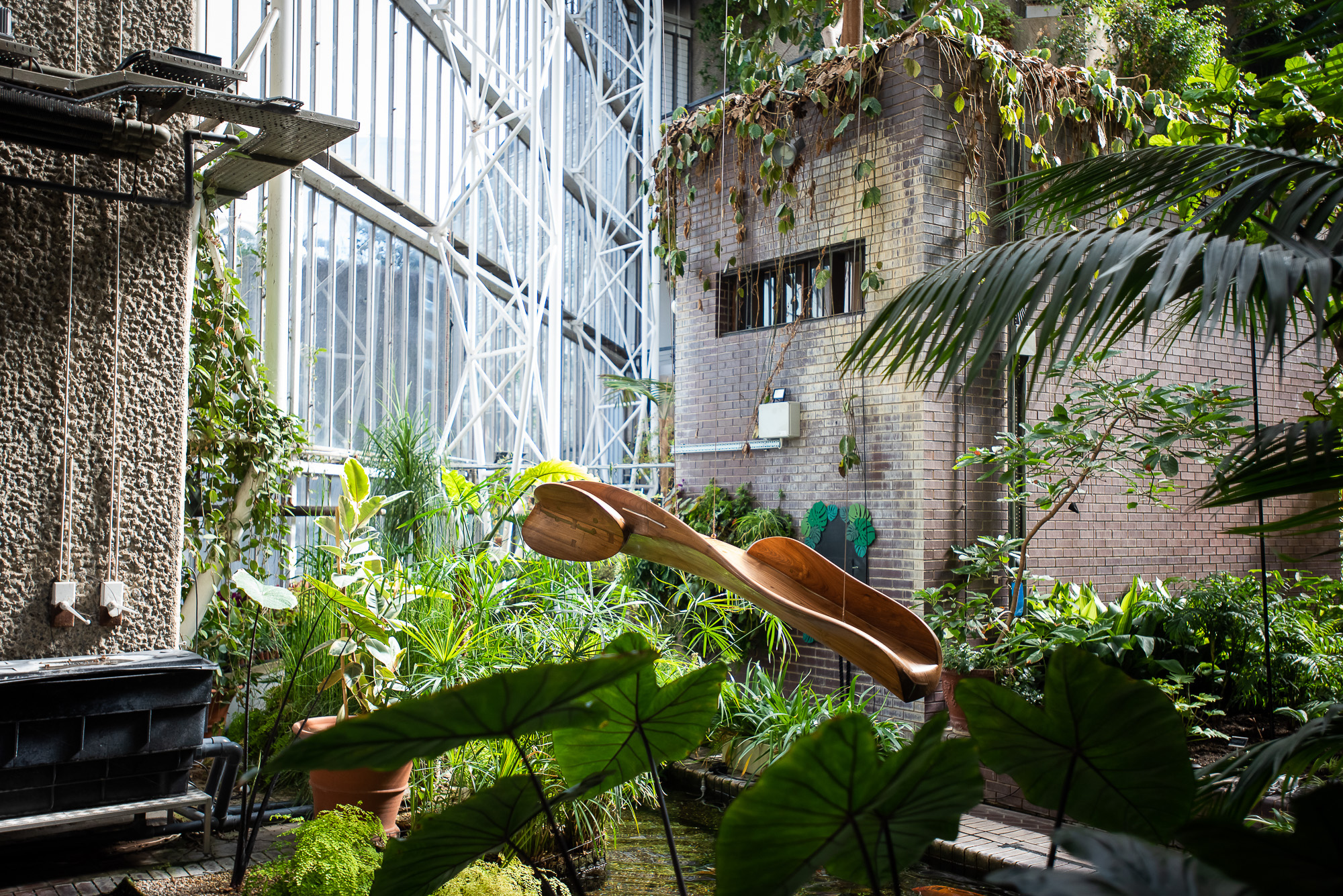
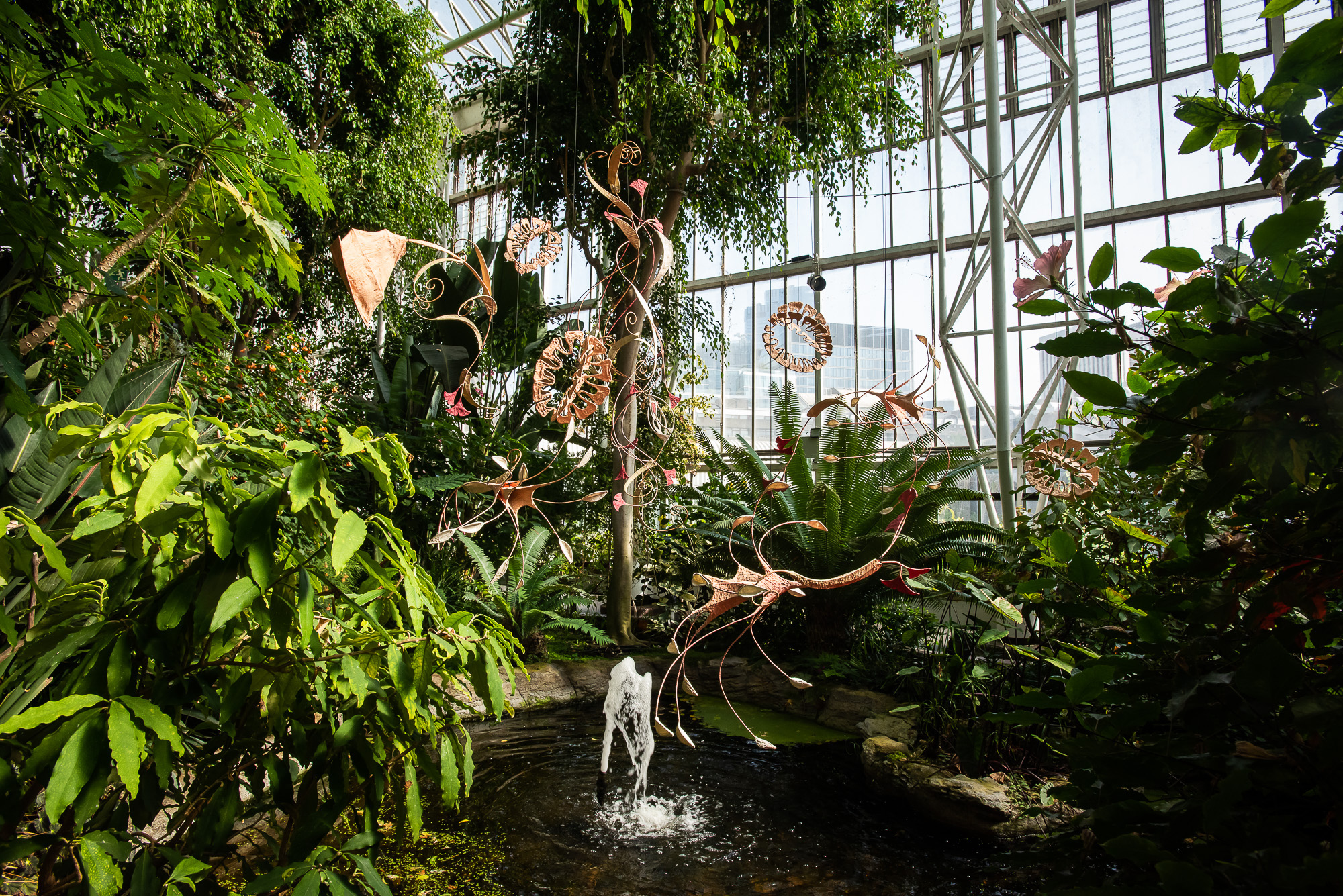
Figs.v,vi
Science is wielded as a sword that penetrates the dark, mysterious haze of nature. A neatly organised greenhouse, with plants from all the places reached by this sword, is a miniature version of the world tamed by the orderly overview. Confined under a glass canopy, the displaced plants become part of a beautiful, harmless snow globe.
The exhibition, however, quietly disobeys the desire for control and order that gave birth to Barbican Conservatory’s colonial predecessors. It submerges visitors in a sea of vegetation and denies their access to an all-powerful vantage point. My view is constantly blocked. I get lost. I look for the sculptures. I can’t find my way out. I touch and smell and hear the space. Without any explicit statement, the sculptures give me a tap on the shoulder, reminding me what an experience like this in a conservatory might imply.
The plants in Barbican Conservatory seem to know all this. Since they first met Shettar in December 2022, when she visited the exhibition site, the plants have grown like mad. Now, their scarred vines spread across the space like twisting pythons, and their massive leaves throw layered shadows into the space. They have trespassed the boundaries of their designated areas, blocked the walkways, hidden the name plaques and, slowly but insistently, grown into one with Shettar’s sculptures. They cover the concrete walls of the conservatory and reach for its glass roof. A dense, unruly, and impenetrable jungle has taken over the place.
Ranjani Shettar (b. 1977 Bangalore,
India) is an Indian sculptor who combines natural & industrial materials to
create large-scale installations. She works with materials including beeswax,
wood, organic dyes, vegetable pastes, lacquer, steel & cloth, creating
immersive environments that are comprised of numerous non-representational
forms & are inspired by her observations of the now-threatened natural
environs of rural India. Living & working in Karnataka, India, she is known
for her focus on nature & ecology. Shettar’s works are in many prestigious
museum collections & have been the subject of several solo presentations
including at The Metropolitan Museum of Art, New York (The MET) (2018), The
Phillips Collection, Washington, DC (2019), National Gallery of Victoria,
Melbourne, Australia (2011), The San Francisco Museum of Modern Art (SFMoMA)
(2009), The Modern Art Museum, Fort Worth, TX (2008-9) & The Institute of
Contemporary Art (ICA), Boston, MA (2008).
Shettar’s works have also been featured in exhibitions at The Museum of Modern
Art (MoMA), NY; Kiran Nadar Museum, New Delhi; 5th Moscow Biennale; 10th
Liverpool Biennial, UK; 55th Carnegie International, Carnegie Museum of Art,
PA; 9th Lyon Biennial, France; 8th Sharjah Biennial, UAE; 15th Sydney Biennale,
Australia; Art Tower Mito, Japan, Artpace, Texas; Cartier Fondation, Paris;
Sainsbury Center, UK; Hermes Fondation, Singapore; Arthouse, NMACC, Mumbai;
Wexner Center, OH; The Walker Art Center, MN; Fondazione Sandretto Re
Rebaudengo, Torino, Italy & Marian Goodman Gallery, New York. For two
decades Ranjani Shettar has been represented by Talwar Gallery, which has
exhibited her works in ten solo presentations.
Cindy Huang lives in London & has recently left her job at a commercial art gallery. She writes about art &, less frequently, food. She is the Co-Editor of Qilu Criticism, an independent online forum formed in 2021 to expand spaces for critical discussions on contemporary art in Chinese. She graduated from the University of St Andrews with a BA in Art History & Courtauld Institute with an MA in Curating. Born & raised in Chengdu, she misses home all the time.
www.qilucriticism.com
www.qilucriticism.com
visit
Ranjani Shettar, Cloud songs on the horizon is exhibited in the Barbican Conservatory until 01 October, entry is free & more information is available at:
www.barbican.org.uk/whats-on/2023/event/the-conservatory-x-ranjani-shettar
images
fig.i Ranjani Shettar, On the Wings of Crescent Moons, 2023. Installation view of Ranjani Shettar Cloud songs on the horizon, Barbican Conservatory 2023.
Courtesy Barbican Centre, KNMA, Ranjani Shettar © Max Colson, Barbican Art Gallery
fig.ii Ranjani Shettar, Cloud songs on the horizon, 2023. Installation view of Ranjani Shettar Cloud songs on the horizon, Barbican Conservatory 2023.
Courtesy Barbican Centre, KNMA, Ranjani Shettar © Max Colson, Barbican Art Gallery
fig.iii Ranjani Shettar, In the thick of the twilight, 2023. Installation view of Ranjani Shettar Cloud songs on the horizon, Barbican Conservatory 2023.
Courtesy Barbican Centre, KNMA, Ranjani Shettar © Max Colson, Barbican Art Gallery
fig.iv Ranjani Shettar, Moon dancers, 2023. Installation view of Ranjani Shettar Cloud songs on the horizon, Barbican Conservatory 2023.
Courtesy Barbican Centre, KNMA, Ranjani Shettar © Max Colson, Barbican Art Gallery
fig.v 11. Ranjani Shettar. Cloud songs on the horizon Installation view, Barbican Conservatory 2023. Courtesy Barbican Centre, KNMA, Ranjani Shettar © Max Colson, Barbican Art Gallery
fig.vi Ranjani Shettar, Above the crest, 2023. Installation view of Ranjani Shettar Cloud songs on the horizon, Barbican Conservatory 2023.
Courtesy Barbican Centre, KNMA, Ranjani Shettar © Max Colson, Barbican Art Gallery
publication date
14 September 2023
tags
The Barbican Centre, The Barbican
Conservatory, Foliage, Greenhouse, Cindy Huang, Jungle, Leaves, Monstera,
Muslin, Post-colonial, Science, Sculpture, Senses, Trees, Ranjani Shettar
www.barbican.org.uk/whats-on/2023/event/the-conservatory-x-ranjani-shettar


